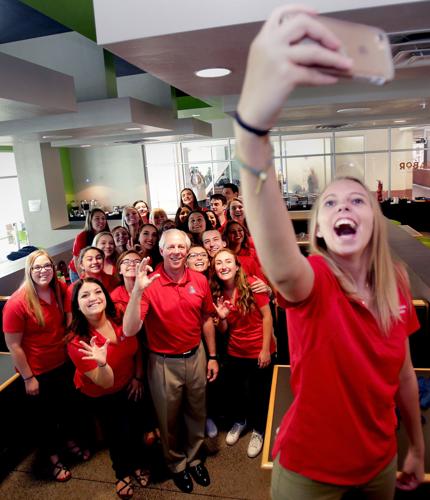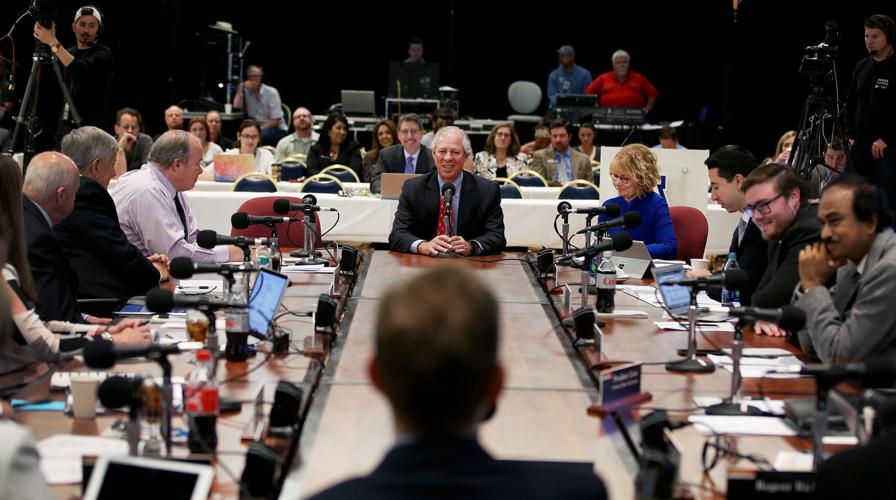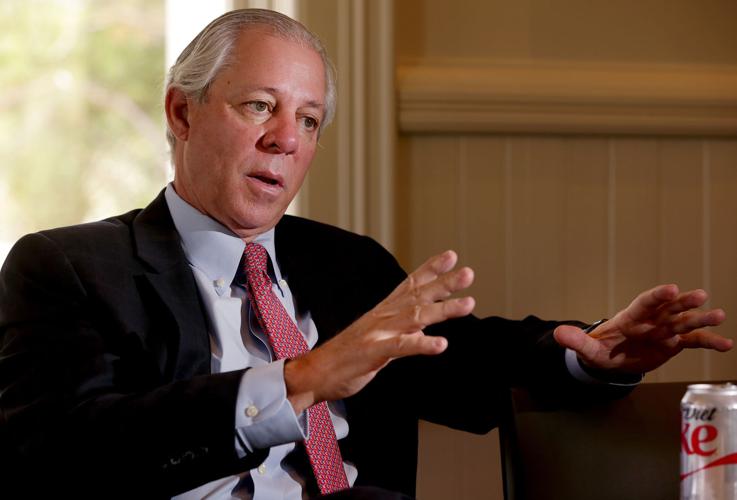The University of Arizona’s new president says he’s someone who can foster unlikely alliances — a skill he’d like to use to unify the campus.
As the CEO of Texas Medical Center, Dr. Robert C. Robbins brought together competitor hospitals and universities. The Mississippi-born cardiac surgeon promises to use those collaborative skills in his new job as the 22nd president of the UA.
Robbins, 59, who introduces himself as “Bobby,” sat down for an interview with the Star on Friday, his second day on the job, as he ate a breakfast of a power bar and a Diet Coke in his office in Old Main.
He said he wants to unify all fronts of UA life — between disciplines, between its people, and also between the UA and other universities. Yes, even through alliances with Arizona State University.
One of Robbins’ first orders of business will be working on a strategic plan. His predecessor, Ann Weaver Hart, had a plan called “Never Settle.” Robbins isn’t close to having a name for his, as it will be a team process, he said.
He also plans on being out and about on campus and in the community a lot. He admits to being a little disappointed that there is no president’s house at the UA, as he would have liked to live on campus.
The following are excerpts of the interview:
What kind of a learning curve will you have?
I am going to be on a very steep learning curve about understanding the culture and the traditions of the university.
It’s also a big jump for me administratively. Going from a large, I would say, medical city. We were going to change the name to Texas Medical City from Texas Medical Center. I was like the mayor of a small town.
In many ways my global impact, my footprint is going to be diminished. People have said to me, why are you doing that?
It was a big job and it was a lot of fun and I enjoyed it. But this is where my heart is. It’s a big step for me, but at least I’ve been in an environment where it was fast-moving, big stakes, big consequences to decisions.
From the day I stepped on the campus and knew I was going to be coming here, my whole mindset changed. I felt like I was back at a university and back where I needed to be.
You are taking a big pay cut to be here (he was making nearly $2 million per year at Texas Medical Center). Why?
I’ve never done anything with a motivation of making money. I’ve always said if I wanted to make money I would have gone to Wall Street and I would have been an investment banker.
What are your first priorities?
To focus on learning more about the university, most importantly the people. Whether they are professors, or students or staff, community leaders, alumni, donors, elected officials, industry leaders — I am spending a lot of time trying to understand who those people are and what their hopes and dreams are, what they really care about. I’m taking an environmental assessment, basically, of the people.
Tell us about your strategic planning process.
We need to get a strategic plan and we need to get on it this summer.
That’s going to take a year or a year and a half to actually do the work. It will be very inclusive. There will be a lot of committee work. I anticipate we will also use surveys and things to engage a broader group of people. It will be very similar to what we did at the Texas Medical Center. Listening, learning, acting on a strategic planning process that will be a road map that will guide the university over the next five to 10 years. We can’t look too much further out than that.
“Never Settle” was a good plan and it served the university well. But I need to put my own stamp on a new plan. Although Never Settle is an evergreen plan, I think we need to go back and go deeper, engage the stakeholders more intensely and really roll out what we are going to do in this rapidly changing world.
Where are we going to make our bets on the future? It’s sort of the (NHL great Wayne) Gretzky thing — we want to skate where the puck is going, not where it is right now.
What were your motivations for transitioning into an academic administrative role?
I spent my whole career in academics. I was at Stanford, started out as assistant professor and worked my way up to leadership positions. I have a lot of experience with fundraising and being a university leader. I was the founding director of a universitywide cardiovascular institute.
That required a lot of administrative skills and leadership skills, plus fundraising. I’d also been involved sort of organically in the whole startup entrepreneurial biotech network of the Bay Area.
I started to accumulate these skill sets and probably 10 years ago I was one of two finalists to be the president — they call it the chancellor — of the University of Mississippi, Old Miss. When this opportunity came to go back to Mississippi and be the president of a comprehensive research university I began to realize where my true passion was.
I believe that universities are, along with some of our prominent institutions like Congress and statehouses and churches, one of the most important determinants of how our country, our society, will move forward.
It’s a place where we can take risk and create cauldrons of discovery that will catalyze changes in society. I can’t imagine a more important, higher calling than having the opportunity to lead a university. I’ve always wanted to do this.
Your $988,000 pay package is the highest for a UA president. Does that set the bar high for you?
Absolutely. I look forward to that challenge and being held accountable.
The fact is that somebody has to pay for something that is of value. If society was willing to pay higher taxes, we could pay for a lot of things. We could pay for health care for everybody. We could pay for higher education for everybody. My sense is that’s probably not going to happen in our lifetime in the U.S.
Somebody’s got to pay for education. This is a very expensive endeavor. We could debate how much is too much. But for those who would say they are never going to be satisfied until it’s all free, any dollar that we make is too much.
State funding for higher education in Arizona has dropped 56 percent per student since the start of the recession, the Center on Budget and Policy Priorities says. Is this affecting education at the UA and if so, how?
I would love to see us invest more money on higher education in the state certainly, but I don’t believe that that has affected the quality of education being delivered at the UA.
There is still a commitment by dedicated faculty members who do this for the love of the game. We’ve found ways through scholarships and finding other streams of revenue to fund the mission that we have. My anticipation is state funding is not going to increase, that it potentially will continue to decrease.
Even in the face of continued decreased state funding — we are not the only place — every state university is facing this. We’ve got to do a better job of running the university more efficiently, trying to save money any way we can and deliver a higher quality education. It’s almost the same as in health care.
The whole point of value-based health care is to deliver the highest quality care at the lowest cost with the best service to the patient and to populations. I see the same parallel in higher education. We can deliver higher quality at lower cost, just like we’re doing in the health-care realm.
We’ve got to find new ways. There’s a Nobel laureate in physics — Carl Wieman, a Stanford guy, and he has focused very much on the area of not just standing up there and giving a lecture and using PowerPoints anymore. That’s just not how the current generation learns.
What’s your sense of tech transfer at the UA?
I think that Tech Launch Arizona has done a great job, but it is just beginning. That is another reason I was so interested in the UA.
There is an opportunity and a lot of white space I think we can run in to be able to change the culture of the university, from experienced faculty members to the junior professors, and I would daresay even to the students.
Once we start to say, you don’t have to go to the Bay Area, you don’t have to go to Boston to have a great idea and we will give you the resources, the intellectual support of how to get your idea from the back of the napkin to the marketplace. ... The way you measure that will be in licensing dollars and income back to the university. It takes some significant investment to be able to do that.
Oftentimes, those investments are really long-term. But for the good of the educational enterprise, you just need a couple of hits.
For instance, the University of Houston doesn’t have a medical school, but they get I think about $27 million in royalty payments and licensing fees from two drugs that they discovered.
Is the Banner Health arrangement with the UA unique in the country?
I don’t think so, no. I’ll give you an example — Baylor College of Medicine and Catholic Healthcare Initiatives. They partnered, and it was one of the first deals I worked on. ... You’ve got this national faith-based, health-delivery system partnering with a private academic health-sciences college.
Academic medical centers in smaller population regions, in order to not just survive, but to thrive, are probably going to have to have some sort of affiliation, some sort of partnership, some sort of joint venture with these big systems.
There was a prediction when the Affordable Care Act was first being promulgated that there would potentially be about 20 to 25 systems throughout the country.
I think that was too small a number. But I think you are going to see less than 100, for sure, major players across the U.S.
Banner is one of the top 10 health-care delivery systems in the country. It was sort of inevitable that we would need to partner with someone in the future. And if we had to partner with anybody, Banner is a great choice. They are large, they understand the game. They understand value-based care, which I absolutely believe we are headed toward.
The name of the game is really trying to take the variation out of the equation, so we do it the same way every time. Therefore you can drop the cost and increase the quality of care.
What can you replicate from Texas Medical Center that could benefit the UA?
Building on the idea that we’ve got many diverse stakeholders that make up the university family. And convincing all of the powerful deans and their supporters and faculty that the competition is not between engineering and medicine.
Across campus we have a team of champions, which means engineering’s great, medicine is great and law and the fine arts. What I hope to inspire is to build a championship team and not just a team of champions.
The idea is that we need to figure out, in this changing world, where digital technology is interfacing with biology.
Just think about sequencing the human genome, only in the last decade.
With physical disciplines, think of driverless cars — and how all these rapidly evolving changes of the so-called fourth industrial revolution are going to impact society.
Some students have been lobbying to make the UA a so-called Sanctuary Campus and adopt policies to protect members of the campus community who are illegal immigrants. Is that something the UA would consider?
My understanding is that’s not legal. There are laws in place that prevent that from occurring.
There has been concern in the medical and science research community about reductions in federal funding for research. Is this a valid concern and if so, is there anything you as president can do to address it?
We will band together with our peer institutions and do everything we can in Washington, D.C., to use our influence to try and preserve funding and increase funding by NIH, by NSF, Department of Defense . ...
We’ve got agriculture, and astronomy and space disciplines, two medical schools, a public health school, a great business school, law and engineering ... all of that gives us a diverse portfolio of options to go after unique funding, whether it be from the Department of Energy, from corporate entities, from foundations.
I think as we go through this strategic planning process we need to think about pulling together not only with the schools and colleges that make up the UA, but think about how we can partner with peer institutions, whether it be in Arizona or outside Arizona.
These big grants and these big proposals now often require multi-institutional commitments to be able to do it. The beauty at Texas Medical Center is that we had 57 institutions on one 2,000-acre campus, so collaboration was a lot easier.
Think about the strengths of the UA and ASU coming together around some of these big ideas. We will be a major factor on the national and international scene if we could figure out how we could work together and make this economically more impactful for the community and the state.
Utah and Nevada have taken advantage of the out-migration of companies from California. I think we should be able to take advantage, also.






